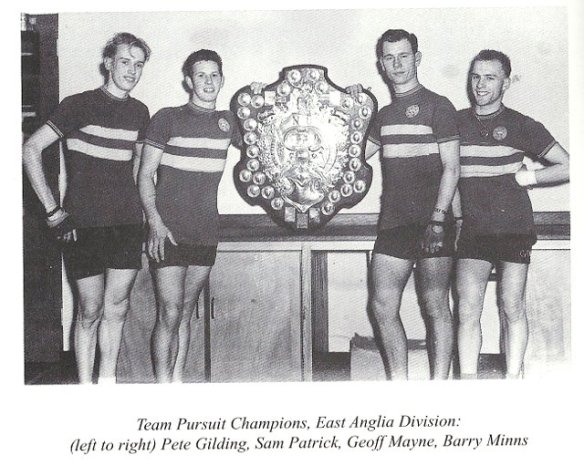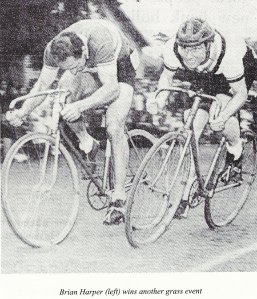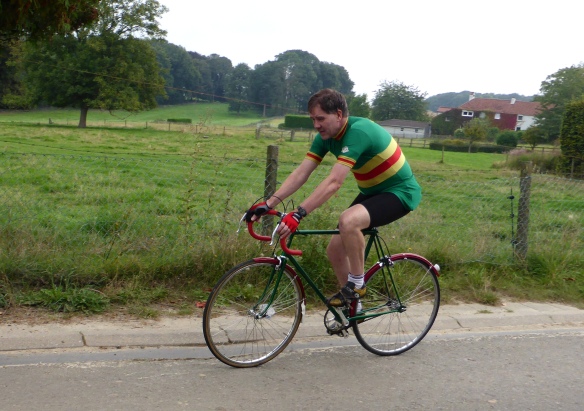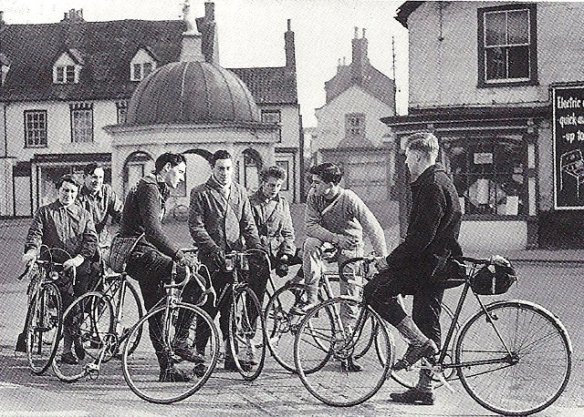Prologue
Late last summer a small ceremony took place at our house. Photographs were taken and an old friend took to the roads.
I dressed for the occasion. Traditional striped cycling jersey, matched with black shorts, white socks and a pair of old-school leather cycling racing shoes polished up for the event.
I then rode on a circuit especially selected for the occasion, mainly flat but with sweeping undulations that encouraged my legs to spin the pedals smoothly. It should have been Suffolk, England, but the lanes of rural Wallonia made an excellent substitute.
This was the christening ride for my restored 1963/4 classic English fixed wheel bike, made by renowned London cycle maker Holdsworthy under the brand Freddie Grubb.
Some readers of idonotdespair.com may recall occasional mentions of my long term project to restore the bike, indeed one of my followers even contacted me to offer help finding the missing parts, he seemed quite frustrated that it was taking so long. Well I can tell you now Chikashi that it is done.
Now I also feel the time is right to tell you the story of Freddie Grubb 11773 and to explain why this machine could no longer languish as a scruffy wreck at the back of my bike shed. A bike so ill-treated that one of my college mates renamed him “Grubbie Fred”, a nickname that stuck for years.
 At the same time that I am writing this post I am reading the excellent “It’s all about the bike” by Robert Penn. Conceptually he is searching the world to build the perfect bike, his dream bike. That could be an incredibly boring except for bike fanatics, but in the hands of a good author it is a chance to weave together an entertaining collection of stories about the people and places from the history of cycling technologies, from the hoax Leonardo da Vinci bicycle to the founding fathers of mountain biking in Marin County California. And I realised that this is what I want to do with the Freddie Grubb.
At the same time that I am writing this post I am reading the excellent “It’s all about the bike” by Robert Penn. Conceptually he is searching the world to build the perfect bike, his dream bike. That could be an incredibly boring except for bike fanatics, but in the hands of a good author it is a chance to weave together an entertaining collection of stories about the people and places from the history of cycling technologies, from the hoax Leonardo da Vinci bicycle to the founding fathers of mountain biking in Marin County California. And I realised that this is what I want to do with the Freddie Grubb.
The restoration has also made me think about a whole series of cycling places and memories that should be shared. That doesn’t mean a piece by piece breakdown of all the parts on the bike, rather it means spreading Freddie’s story over a few pieces that capture some of cycling’s past, and my own. Because this bike does have a story to tell and perhaps that is why I gradually became guiltier about its decline under my stewardship.
This bike has spent its life in one cycling club, and mostly in one small area. It is a representation of a certain time and place, the fading tradition of fixed wheel bikes in East Anglian cycling. And it is one of a tiny number of bikes on the planet that can claim to be a Guinness World Record breaker – and that does make it special.
Chapter 1. Godric CC and grass track racing.
In my mind this bike represents Godric Cycling Club, my club, the one I grew up with and formed my cycling experiences. (I wrote about the Godric earlier this year here)
I bought the frame sometime around 1973 or 1974 when I had become a gangly teenager and grown out of whatever previous fixie Dad had knocked up for me, and I had a little bit of money saved from my paper round.
I bought it from older club colleague Ross Mullenger, who I think was selling some bits because he had drifted away from regular club riding. It probably cost about £15. I learned later that it was already a club hand-me down from Lindsay Wigby, long standing family friend and club member. It was only when researching the provenance of the bike for the restoration that I identified it as a Freddie Grubb Comet probably made in 1963 or 1964. The brilliant www.nkilgariff.com has a complete history of the Holdsworth and Freddie Grubb marques and even has a catalogue of the 1964 Comet on line.

Freddie Grubb Comet catelogue on http://www.nkilgariff.com
I then went back to Lindsay to ask if he had got it as an original because he was riding with club then.
He filled in the gaps by telling me the original owner was Pete Gilding, one of the few Godric names I didn’t know, but someone who had been actively racing with the club at that time. A quick dip into the published club history and I found a picture of Pete with my Dad after they won the impressive Norwich CU grass track team pursuit shield in 1958.
Too early for my bike to have been one of the winning steeds, but a great link to the origins of the Freddie Grubb because they would all have been using grass track bikes like mine, perhaps handed round in just the same way.
But I now knew that this is a one-club bike which throughout its life has carried the green colours of the Godric CC. Hence my selection of the green, yellow and red banded Godric cycling shirt for the christening ride. And here we are, a photo of another Godric ride and in the middle is that sprouting teenager in blue stripy bobble hat with the green bike. It must be around the time I bought the frame and first fitted it out. Previous owner Lindsay is three places to the right in black.
Elsewhere a teenager buying a fixed wheel bike in 1974 might raise a few eyebrows, but it really would not be a surprise for anyone who was in Norfolk or Suffolk club cycling. Many riders round there had a “fixed” or “track bike” set up for road riding despite the fact that their use as club riding bikes had almost died out across the rest of the country. (We never called them “fixies”, that is an entirely modern phrase).
Because no, the couriers and hipsters did not take fixies straight from track racing to the road in the last 10 years. In British cycling the racing scene excluded mass start road racing until the late 50s and cyclists in most racing clubs thrived on a mixture of time trialling and club riding with occasional diversions into grass track racing and roller racing. Most time trialling was done on fixed wheel bikes that could be converted from one use to another with a change of wheels. These were not the steep angled, aerodynamic track machines used on today’s velodromes, these were machines that could fit mudguards one day and race the next.
I think this tradition carried on much longer in Suffolk and Norfolk than almost anywhere else for a number of reasons, not least of which could be that it is one of the flattest places in the country so a simple single gear is really not a handicap for spinning around the countryside. Almost the first “proper” bike Dad put me on was a fixed wheel, not least because it would be ”good for my pedalling.” They were also a lot simpler to maintain and a lot less prone to problems on mucky roads so they were popular winter road bikes, often referred to as the “hack bike”.
Another possible reason fixies stayed on in our area was that we still had opportunities to race on fixed bikes while other parts of the country converted almost completely to road riding using 10 speed derailleurs. In particular there was grass track racing which only survived in a handful of places across the UK. East Anglia was one of the hotbeds and as a child in the 60s I can remember being taken to a whole series of carnivals and rallies where the cycling crowd would come together. I probably rode my first bike race in the kiddies’ handicap events at a grass track meeting. The adults would pull out another pair of wheels with rubber studded tyres, put them in their fixed bike and race round a single white line painted on the field, sometimes with fields of 20-30 riders. Hopefully it was a nice cricket ground or school sports field, at worse it could be like riding in slow motion across a lumpy paddock.
By the time I bought the Freddie Grubb in 1974 many of the meets had died out, but we could still expect to race several times a year on grass and we would train every Wednesday on our club track at the Ditchingham Meadow sports grounds. So it was essential that I had a track bike of my own.
This photo is one of my favourite cycling pictures, taken by the local paper at one of our regular races in Bungay, probably our club championship in about 1976/77. I love the sense of competition and motion in the two riders at the front. Andy Warne being shadowed by Richard Avery, probably about to try and pounce for the win. I am the white helmet in third and that’s about as far forward as I got in most races.
 Actually Freddie and I did sneak an Area Championship win once with some highly tactical riding. In the short one-lap race I got the perfect draw for the final, number 1 on the inside. I then asked canny track star Brian Harper (right) to be my pusher off, the builder with the strongest arms in cycling. As we waited on the start line Brian whispered in my ear “I am going to push on the whistle, don’t wait for the gun”.
Actually Freddie and I did sneak an Area Championship win once with some highly tactical riding. In the short one-lap race I got the perfect draw for the final, number 1 on the inside. I then asked canny track star Brian Harper (right) to be my pusher off, the builder with the strongest arms in cycling. As we waited on the start line Brian whispered in my ear “I am going to push on the whistle, don’t wait for the gun”.
Spectators would have observed a metaphorical greyhound race where the rabbit shot out ahead of the dogs before they even moved. Somehow the judges neglected to call it a false start, just as Brian had guessed. Jet propelled by Brian’s shove I had a ten yard head start at the first corner which was reduced to the width of a tyre as four of us hit the finish line 400 yards later, but I held on for a very rare win.
All I can say is “track craft”. Anything goes in grass track racing.









Outstanding!
LikeLike
Thanks. it has taken me months to get round to writing it, but now I have done so I wonder why I delayed. 2 more chapters to make the set.
LikeLike
Looking forward to it. last week I was riding in Arizona and as I rode by a cactus there about 30 bright green parrots sitting in it ( winter visitors from the rain forest ) – I just love my bike
LikeLike
Absolutely wonderful story, Kevin! And Freddie does not look Grubbie any more!
I think I would have loved grass track racing…
LikeLike
Yes, they were good days out. If you ever have the chance to be in Mildenhall, Suffolk on the last weekend of August you must go to the Mildenhall Rally, one of the last survivors.
As well as the grass track racing there are audax rides, sales tents, second hand sale etc. etc, all lasting 3 days.
LikeLiked by 1 person
Great story, and an entertaining bit of cycling history.
LikeLike
Thanks Frank. I guess some of your crowd came from the same traditions?
LikeLiked by 1 person
Memories – back in the early ’80’s – when I couldn’t afford a car – I bought a Freddie Grubb framed bike from a chap named Ron Howe – the bike was apparently his Mum’s and from the ’50’s – Ron played Sax on a couple of the Cure tracks! I remember riding it home in the small hours after working nights – the roads were quieter then.
LikeLike
The question is of course “where is it now?”
Hopefully a collector has picked it up, or has it gone to the scrap heap in the sky?
LikeLike
I donated to friend who needed a bike – the last time I saw it was about 25 years – it had been neglected and am guess it went to the bicycle heaven.
LikeLike